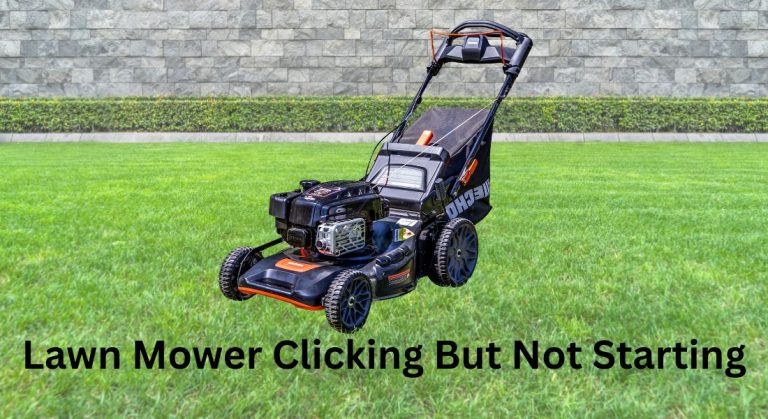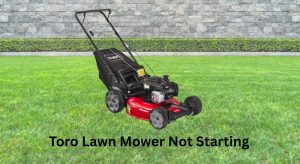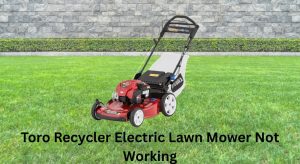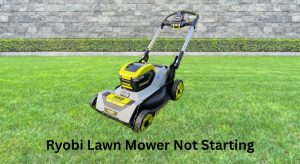You press the starter or pull the cord, hear a click, and… nothing. It’s frustrating, especially with grass growing fast. If your lawn mower is clicking but not starting, the quickest fix is often to check and clean the battery terminals (for electric start), tighten the ground connection, or reseat the spark plug wire. Many times, a weak battery, corroded terminals, or a stuck starter solenoid is the culprit.
In this comprehensive guide, you’ll learn all the common causes behind a lawn mower clicking with no start—both gas and electric-start models—and how to fix each one step-by-step. From battery tests and solenoid checks to fuel and spark troubleshooting, you’ll have multiple solutions to get your mower running reliably by the end.
Common Causes of a Lawn Mower Clicking But Not Starting
- Weak or dead battery (electric start mowers)
- Corroded or loose battery terminals/ground cable
- Faulty starter solenoid or starter motor
- Bad ignition switch or safety interlock (seat, blade, brake)
- Poor spark (loose spark plug wire, fouled plug, bad coil)
- Hydro-locked engine (flooded cylinder with fuel)
- Bad fuel, clogged carburetor, or blocked fuel filter
- Seized or jammed blade/drive system preventing cranking
- Blown fuse or damaged wiring
- Low oil (on engines with low-oil shutdown)
- For cordless electric mowers: low charge, bad battery pack, or controller fault
How to Fix a Lawn Mower Clicking But Not Starting

Before you start: Always remove the key and disconnect the spark plug wire when working around the engine. For battery checks, wear gloves and eye protection.
Method 1: Quick Electrical Checks (Fast, High Success Rate)
Diagnosing the Issue
Clicking usually means your starter solenoid is attempting to engage but there isn’t enough power to crank, or the starter is stuck. Start with the simplest causes: battery and connections.
Fix Steps
1) Check safety interlocks (30 seconds)
– Ensure the brake/clutch is fully engaged.
– Ensure the blade PTO is OFF.
– Sit on the seat (for riding mowers).
– Set the gear to neutral.
2) Inspect battery connections (3–5 minutes)
– Lift the seat or access the battery compartment.
– Look for white/green crust on terminals, loose clamps, or frayed cables.
– Wiggle the ground cable where it bolts to the frame—ensure it’s tight and clean.
3) Clean and tighten terminals (5–10 minutes)
– Disconnect negative (black) first, then positive (red).
– Scrub with a wire brush and a baking soda/water paste to neutralize acid.
– Dry, then apply dielectric grease (optional).
– Reconnect positive first, then negative, and tighten snugly.
4) Try a jump start (2 minutes)
– Use a 12V car battery or jump pack on riding mowers.
– Connect red to positive (+), black to chassis ground, not directly to the battery negative if possible.
– Start the mower; if it cranks and runs, your battery is weak and likely needs replacement.
5) Check the fuse (1–2 minutes)
– Many mowers have an inline fuse near the battery or ignition switch.
– Replace if blown with the exact rating.
Testing
- Turn the key. If the click is gone and it cranks strongly, you’ve solved it.
- If still clicking, continue to Method 2.
Method 2: Battery and Solenoid Testing (Targeted Diagnosis)
Diagnosing the Issue
A healthy 12V battery at rest should read ~12.6V. Below 12.2V suggests low charge; 12.0V or less is effectively discharged. Clicking with proper voltage can point to a bad solenoid, weak ground, or starter motor issue.
Fix Steps
1) Measure battery voltage (2–3 minutes)
– Use a multimeter set to DC volts.
– 12.6V: Good. 12.4V: 75% charge. 12.2V: 50%. 12.0V: Discharged.
– If low, charge the battery for 2–4 hours and retest.
2) Load test the battery (5 minutes)
– If you have a load tester, follow instructions to verify capacity.
– Without a tester: watch voltage while attempting to start.
– If it drops below ~9.6V during crank and you only hear clicks, the battery is likely bad.
3) Check the ground and starter cable (3–5 minutes)
– Ensure the ground strap from battery to frame is shiny clean where it mounts.
– Check cable from battery positive to solenoid and from solenoid to starter for corrosion or damage.
4) Test solenoid function (5 minutes)
– Listen for a distinct click from the solenoid as you turn the key.
– With a multimeter, check for 12V on the small trigger wire at the solenoid when key is in START.
– If trigger power is present but no high-current output to the starter, the solenoid is likely bad.
5) Bypass test for starter (Advanced; use caution)
– Briefly bridge the two large terminals on the solenoid with an insulated screwdriver.
– If the starter cranks, the solenoid is bad. If no crank, suspect the starter motor or a ground issue.
– Important: Keep hands clear; sparks are normal but be careful.
Testing
- Replace the solenoid if it fails tests.
- If the starter still won’t turn with direct power, proceed to Method 3.
Method 3: Starter Motor and Mechanical Checks
Diagnosing the Issue
If electrical power is good but the engine won’t turn, the starter motor may be seized, the engine may be hydro-locked, or the blade/drive system is jammed.
Fix Steps
1) Check blade and deck (2–4 minutes)
– Disconnect spark plug wire.
– Flip or tilt the mower carefully—tilt carburetor side up on walk-behind models to avoid flooding.
– Remove sticks, rope, or built-up grass clumps from the blade area.
– Ensure blade can rotate by hand (use a glove). It should move with resistance but not be stuck.
2) Inspect the starter gear (Bendix) on walk-behind mowers (3–5 minutes)
– Remove the blower housing if needed.
– Check if the small plastic/metal starter gear is stuck or stripped.
– Clean the gear and shaft; apply a light dry lube (not heavy grease).
3) Check for hydro-lock (3 minutes)
– Remove the spark plug.
– Pull the starter rope several times or crank for 2–3 seconds to expel excess fuel/oil from the cylinder.
– If liquid sprays out, wipe clean, dry the plug or replace it, then try again.
4) Starter motor bench checks (Advanced)
– On riding mowers, remove starter and apply 12V directly on the bench.
– If it spins weakly or not at all, replace the starter.
Testing
- Reassemble, reconnect the plug wire, and start. If it now cranks, you’ve cleared the mechanical bind.
Method 4: Fuel and Spark Troubleshooting (When It Cranks but Won’t Fire)
If the click turns into cranking but the engine still won’t start, focus on fuel and spark.
Diagnosing the Issue
Old fuel, clogged carb jets, fouled plug, or bad ignition coil are common.
Fix Steps
1) Spark plug service (5–8 minutes)
– Remove the plug; inspect for soot, oil, or wear.
– Clean with a wire brush and set gap per engine (typically 0.020–0.030 in; check your manual).
– Replace if worn. Ensure the plug wire snaps on securely.
2) Fresh fuel (2 minutes)
– Drain old fuel (>30–60 days old) and refill with fresh gas.
– Add a carb cleaner or fuel system cleaner if needed.
3) Air filter check (1–2 minutes)
– Replace a soaked or heavily clogged filter.
– Try a brief start with the filter removed to rule out airflow blockage.
4) Carburetor clean (15–30 minutes)
– Close the fuel valve (or clamp the line).
– Remove the carb bowl; clean jets and bowl with carb cleaner.
– Replace bowl gasket if damaged and reassemble.
5) Check fuel flow (3–5 minutes)
– Ensure fuel flows freely from tank to carb.
– Replace clogged fuel filter or check for collapsed fuel line.
Testing
- Attempt start. If it fires and runs, you’re done. If not, proceed to safety interlocks and ignition tests.
Method 5: Safety Switches and Ignition Switch
Diagnosing the Issue
Seat, brake/clutch, and blade PTO switches can prevent starting or cause only a click. A faulty ignition switch can also send partial power.
Fix Steps
1) Seat and brake switch check (3–5 minutes)
– Wiggle and firmly engage levers/pedals.
– Inspect switch connectors for corrosion or loose fit.
– Use a multimeter to test continuity when actuated.
2) PTO/blade switch (3 minutes)
– Ensure the switch is OFF and functioning.
– Unplug/replug connector to clean contacts.
3) Ignition switch test (5 minutes)
– Verify 12V at the correct switch terminals in RUN and START positions.
– If intermittent, replace the switch.
Testing
- If switches test good and power pathways are intact, re-test starting. If it still only clicks, the issue is likely battery, solenoid, starter, or wiring continuity.
How to Prevent Future Starting Issues
- Keep the battery on a smart maintainer during off-season.
- Clean battery terminals every spring and mid-season.
- Use fresh fuel and add stabilizer if storing >30 days.
- Change oil and filter at recommended intervals; check level before mowing.
- Sharpen and balance blades to reduce start load.
- Store the mower in a dry, covered area to protect wiring and connectors.
- Inspect safety switch wiring annually for wear or rodent damage.
Pro Tips
- Charge overnight after every 3–4 mowing sessions if you have short runs that don’t fully recharge the battery.
- Replace mower batteries every 3–5 years; test annually before the season starts.
- When jump-starting from a car, keep the car engine OFF to avoid voltage spikes.
- Label and photograph wiring before removing the starter or solenoid to simplify reassembly.
- If you hear rapid repeated clicking, it’s almost always a weak battery or poor connection—focus there first.
- Avoid tilting a mower on the air filter/carburetor side; it can flood and cause hydro-lock.
- Use dielectric grease on connectors and the ignition switch to prevent corrosion.
Professional Help: When to Call a Technician
- The starter spins but grinds or doesn’t engage the flywheel (possible flywheel ring gear damage).
- You smell burning or see smoke near wiring or the starter.
- Repeated blown fuses indicate a short circuit.
- The engine is seized and cannot be rotated by hand even with the spark plug removed.
- Safety interlocks show strange readings and you’re not comfortable with electrical diagnosis.
What to look for in a service provider:
– Small engine certification, good reviews, and transparent pricing.
– Turnaround time and warranty on parts/labor (typical 30–90 days).
Typical costs:
– Battery: $35–$90 (walk-behind) / $50–$150 (riding).
– Solenoid: $15–$40 part; $60–$120 installed.
– Starter motor: $60–$200 part; $100–$250 installed.
– Carb clean/rebuild: $80–$180 shop rate.
Warranty considerations:
– Newer mowers may have coverage on electrical components; check your manual before DIY repairs to avoid voiding coverage.
FAQ
Q: Why does my lawn mower only click once when I turn the key?
A: A single click usually means the solenoid engages, but there isn’t enough current to turn the starter. Common causes are a weak battery, corroded terminals, a bad ground cable, or a failing solenoid.
Q: Can I jump-start my riding lawn mower with a car?
A: Yes, but keep the car engine off. Connect positive to positive and negative to a clean chassis ground. Start the mower, then disconnect. Prolonged cranking can overheat cables—limit attempts to 10–15 seconds.
Q: My walk-behind pull-start mower clicks near the handle. What is that?
A: Some walk-behind models with an electric starter or blade brake clutch can click if the brake cable isn’t fully engaging or if the starter gear is stuck. Check cable tension, starter gear, and ensure the blade zone control bar is pulled tight.
Q: What voltage should a good mower battery have?
A: About 12.6V at rest. During cranking, it should not drop below ~9.6V. Anything significantly lower suggests the battery is weak or there’s high resistance in the circuit.
Q: Could bad fuel cause a clicking sound?
A: Indirectly. Bad fuel won’t usually cause clicking by itself, but it can cause multiple start attempts and drain the battery, leading to clicking from a low battery or weak connections.
Q: How do I know if my solenoid is bad?
A: If the solenoid clicks and you have battery power and a good ground, but there’s no voltage on the starter output terminal while in START, the solenoid is faulty. Bypassing the solenoid to the starter and getting a crank also confirms a bad solenoid.
Q: What if the engine won’t turn even with the spark plug removed?
A: The engine may be seized or locked by a serious mechanical failure. Do not force it. Seek professional diagnosis.
Q: My cordless electric mower clicks but won’t start. What should I check?
A: Verify the battery pack is fully charged, seated properly, and free of debris. Check the safety key, handle levers, and blade obstruction. Some models have thermal or overload protection—let it cool and try again.
Alternative Solutions
If repeated starting issues persist, consider these options:
| Solution | Pros | Cons | Best For |
|---|---|---|---|
| Battery maintainer/charger | Extends battery life, reliable starts | Requires outlet, small cost | Seasonal storage, infrequent mowing |
| Upgraded AGM battery | Better cranking, lower self-discharge | Higher price | Cold climates, heavy-duty use |
| Manual shutoff valve + fuel stabilizer | Prevents carb gumming | Extra step after mowing | Long storage periods |
| Push mower (non-electric start) | Fewer electrical failures | More effort to start | Small yards, minimal maintenance |
Get Your Lawn Mower Working Again
Following this guide, you now have multiple solutions to fix a lawn mower clicking but not starting:
– Clean and tighten battery terminals and ground connections
– Test and charge/replace the battery
– Diagnose and replace a faulty solenoid or starter
– Clear blade jams and resolve hydro-lock
– Service spark plug, fuel, and carburetor
– Verify safety switches and ignition systems
Don’t let a simple click sideline your weekend. Work through these methods in order—from quick electrical checks to starter and fuel troubleshooting—and you’ll get your mower back in action fast.
Have you fixed your lawn mower clicking issue? Share what worked for you in the comments to help other readers. Found this guide useful? Bookmark it for the next mowing season.





